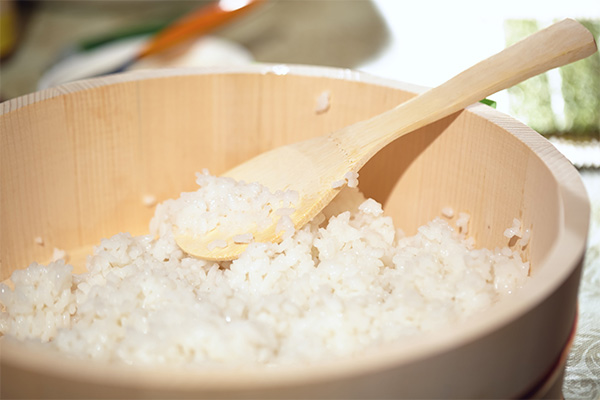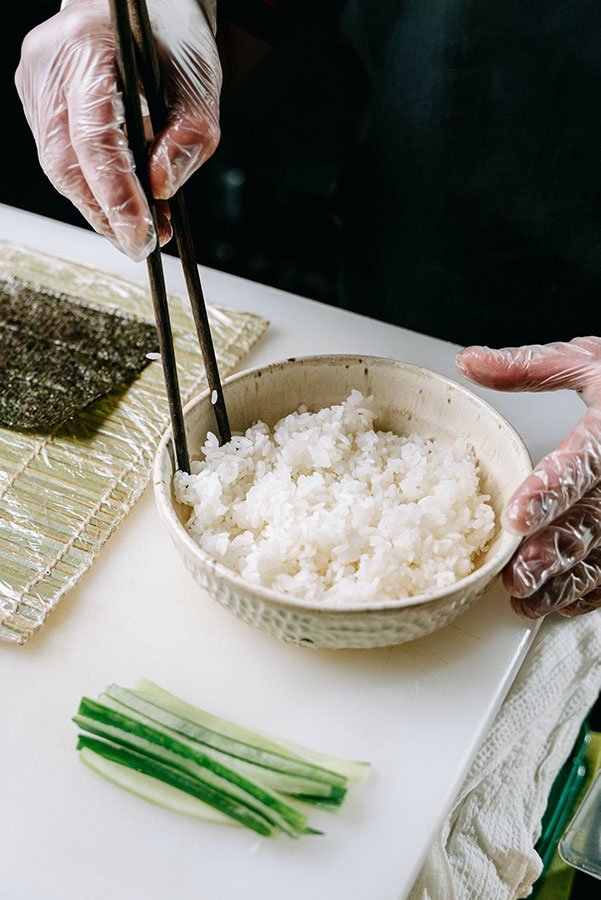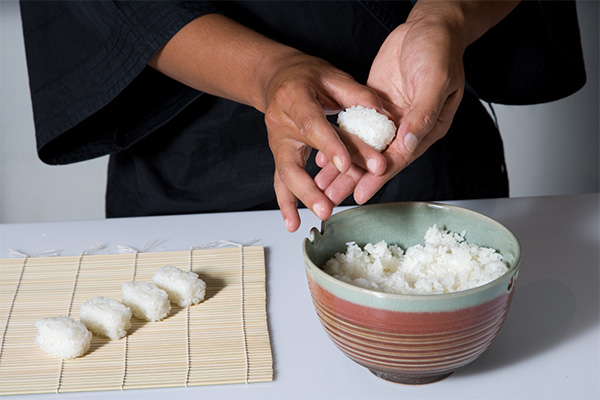There's something about the sushi rolls, nigiri sushi, and other sushi recipes served at sushi restaurants that seems almost unattainable when you try to recreate them at home. Part of that is the freshness of the fish, of course, but a large part is the sushi rice! If you can make authentic sushi rice, your homemade sushi night will be incredible!
Making sushi rice is different from making other types of plain rice. There's more involved than simply tossing rice and water into a rice cooker or pot. But just because it's more involved doesn't mean it's difficult! You can make perfectly seasoned sushi rice at home with a few extra steps and ingredients.
In this post below, we will share how to make sushi rice so you can make your own homemade sushi rice and make sushi rolls.
What Is Sushi Rice?
Sushi rice comes together by cooking Japanese short-grain rice and promptly infusing it with sushi vinegar or Japanese rice vinegar mixture while the rice maintains its warmth. This creates vinegar-flavored rice that is sticky, shiny, and slightly firm. It holds its shape in the various sushi recipes it is used in and adds a firm bite that contrasts with the softness of the raw fish and steamed vegetables.
How Is Sushi Rice Different?
Sushi rice is a special type of rice that is distinct from other varieties due to its unique characteristics and preparation methods. Sushi rice has different starch compositions and characteristics than long-grain rice, jasmine rice, or basmati rice.
The starch in sushi rice is predominantly amylopectin, which is responsible for the stickiness and cohesive texture that are essential for holding sushi together. When cooked correctly, sushi rice possesses a pleasantly sticky and slightly chewy texture. This adhesive quality is essential to maintain the rice's structural integrity in various sushi or sushi donut creations.
What You Will Need To Make Sushi Rice

Short-Grain Japanese Rice
Short-grain rice is preferred for crafting sushi, frequently identified as "sushi rice" or "sticky rice." This rice variety boasts an elevated starch content, which imparts the distinct stickiness synonymous with sushi rice.
Unseasoned Rice Vinegar
Rice vinegar is an essential component in seasoning sushi rice. It contributes a tangy taste and is crucial in harmonizing the sweet and salty elements.
Sugar
Sugar is used to sweeten the sushi rice and balance the flavors. It's an essential component of the seasoning mixture.
Salt
Salt is employed to elevate the overall flavor profile of the sushi rice. It's combined with the sugar and rice vinegar to create the seasoning mixture.
Kombu (Optional)
Kombu is a type of edible kelp or seaweed commonly used in Japanese cuisine. It is a key ingredient in making dashi, a foundational Japanese cooking stock, and is also used to enhance the flavor of various dishes, including sushi rice.
How To Make Sushi Rice

There are many ways to cook sushi rice right in your kitchen. You can use a pot on the stovetop, a steamer basket, a rice cooker, or a donabe. However, cooking sushi rice is done the easiest and most consistently in a rice cooker! All rice cooker instructions list the specific settings needed for sushi rice, and some have a specific "sushi rice" button right on the cooker itself. Here is the best sushi rice recipe for cooking delicious sushi rice right in your kitchen
Ingredients
2 cups short-grain Japanese rice
1/3 cup unseasoned rice vinegar
3 tablespoons sugar
1 teaspoon salt
Optional: a small piece of dried kombu (about 1 square inch)
Directions
Rinse And Soak The Rice
It's very important to ensure all excess starch has been completely rinsed from the rice. If the starch remains on the rice, you will never achieve that perfect sushi rice texture! To rinse the rice, place the measured dry rice into a sieve and thoroughly rinse it under cold running water until it is clear.
Subsequently, immerse the rice in fresh water and allow it to soak for a minimum of 30 minutes. This early hydration step is needed to give sushi rice a sticky texture. The sushi rice grains are also shorter and plumper than other types and need this "head start" to absorb moisture throughout the center.
Add Kombu To The Rice
Although not absolutely essential, seasoning sushi rice with kombu is crucial for preparing fragrant sushi rice. As mentioned earlier, kombu (dried kelp) can be used to add a subtle fragrance and umami flavor to sushi rice.
Cooking rice with kombu, a form of dried kelp, is crucial for achieving authentic Japanese sushi rice. Kombu imparts a delicate aroma and adds a subtle umami taste to the rice.
Add Rice And Water To A Rice Cooker
If you've followed the recommended soaking step (and it's advised to do so), the ideal water-to-rice ratio for achieving exceptional sushi rice is 1 cup of water to 1 cup of uncooked rice. Add all the rice you rinsed, kombu, and room-temperature water to the rice cooker bowl.
Select Your Rice Cooker Setting (For Rice Cooker)
Your rice cooker might have a specific setting to help you make sushi rice. If so, use it! If not, check the owner's manual of your rice cooker. It will have the time and temperature settings to use to make sushi rice.
Cook Sushi Rice On The Stovetop (For Stovetop)
In a medium size pot with a tight-fitting lid, combine rice, water, and kombu. Set the pot over medium-high heat and bring the contents to a boil. Upon reaching a boil, lower the heat to a gentle simmer and cover the pot with its lid. Allow the rice to simmer for approximately 15-20 minutes. Be aware that the specific cooking duration might differ based on your stove and the variety of rice used. As you approach the end of the anticipated cooking time, it's advisable to check the rice for its desired texture.
Let The Sushi Rice Steam
After the rice has finished cooking, let it sit and steam in the rice cooker for ten minutes.
Prepare The Seasoning Mixture
While the sushi rice is cooking, you can start preparing the seasoning mixture. In a small saucepan, combine rice vinegar, sugar, and salt together. Heat the rice vinegar mixture over low heat, stirring until the sugar and salt completely dissolve. Remove from heat and let it cool.
Season Sushi Rice
Once the sushi rice has been cooked, transfer it to a bowl made of wood or non-metallic material. Employ a wooden spoon, spatula, or rice paddle to fluff the rice delicately.
You'll be dealing with sticky rice, so either moisten the bowl lightly with water or line the baking sheet with parchment paper. This allows the rice to cool off as quickly as possible. Many sushi restaurants use an electric fan to cool the cooked rice even faster.
As soon as you transfer cooked rice, be sure to pour the cooled seasoned rice vinegar mixture all over the hot rice. The cooked rice must be hot to take on these important flavors - not warm or cool! Use the rice paddle to combine the sushi vinegar mixture with the sushi rice, but do so in a slicing motion. It's crucial to avoid crushing individual rice grains.
Cover With A Towel
Once you've finished mixing in the sushi rice vinegar mixture, cover the bowl or baking sheet with a damp towel and leave it at room temperature until you're ready to put together your sushi rice recipes!
Tips For Cooking Sushi Rice
Choose The Right Rice
Opt for short-grain Japanese rice or a variety labeled as sushi rice. These rice grains have a higher starch content that contributes to the desired stickiness essential for sushi.
Rinse Thoroughly
Rinsing the rice removes surface starch, which can cause the rice to become overly sticky or mushy. Position the rice within a strainer and thoroughly rinse it under cold water until it runs clear.
Soaking (Optional)
While soaking sushi rice is an option, it helps the grains absorb water evenly during cooking and shortens the cooking time. Drain well after soaking to prevent excessive moisture.
Never Stir Your Rice While It's Cooking
Stirring rice once it starts cooking can break grains and make them gummy. Let the rice simmer without stirring until it's cooked.
Allow The Rice To Rest
Allowing the rice to rest with the lid on after cooking helps distribute moisture and ensures an even texture throughout the rice.
Gentle Mixing
Use a cutting and folding motion to incorporate the seasoning mixture into the rice. This maintains the individual rice grain structure.
Frequently Asked Questions

Why Is Vinegar Used In Making Sushi Rice?
Centuries ago, in the days before refrigeration, raw fish was stored by surrounding it with fermented rice. The fermented rice was discarded when it came time to consume the fish. But at some point, the Japanese stopped using fermented rice for this and switched to adding vinegar to regular rice. It increased the shelf life of the fish, which was the original intention, but it also wound up improving the flavor of the rice! Consequently, they began consuming the fish alongside the rice, eventually evolving into what we now recognize as "sushi"! We no longer need vinegar to preserve raw fish; that sour flavor has become traditionally associated with sushi.
How Much Rice Should I Use?
A good rule of thumb is that one rice cooker cup of uncooked rice (which is the rough equivalent of 3/4 cup in standard measurement) equals two servings of cooked rice. A serving of rice is enough for one sushi roll, one Japanese rice bowl, or two onigiri rice balls. So, if you need to make four sushi rolls, you'll need to use two rice cooker cups of uncooked rice. Need to make 5 Japanese rice bowls? Then split that number in half - giving you 2 1/2. That's how many rice cooker cups of uncooked rice you'll need!
How Do I Know If Sushi Rice Is Perfectly Cooked?
The perfect sushi rice is fluffy in texture but retains a firm bite. If you use fresh rice, the surface of each grain should have a glossy appearance. Every rice grain should possess stickiness without venturing into a mushy consistency. If your rice is mushy and doesn't retain its shape, that is a sign that you used too much water.
Can I Use Regular Rice For Sushi?
While short-grain Japanese rice is recommended for its sticky texture, you can use other types of rice with similar characteristics, like medium-grain rice. However, long-grain rice is not ideal for sushi because it is less sticky.
Should I Season The Rice While It's Hot Or Cold?
Sushi rice should be seasoned while it's still warm. This enables the rice to assimilate the flavors present in the seasoning mixture.
How Do I Cool Sushi Rice Properly?
Employ a fan or apply a fanning technique as you gently blend the rice, promoting even cooling. This process also imparts a glossy finish to the rice. Avoid using a metal bowl for cooling, as it can heat up and affect the rice texture.
How Do I Prevent Sushi Rice From Becoming Too Sticky?
Thoroughly rinsing the rice before cooking and ensuring the appropriate water-to-rice ratio can help manage the desired stickiness level. Also, avoid over-mixing the rice when seasoning it.
Can I Make Sushi Rice In Advance?
Indeed, it's possible to prepare sushi rice a few hours ahead of time and store it with a covering at room temperature. Avoid refrigerating sushi rice as it can affect the texture and flavor.
How To Store Leftover Sushi Rice?
After the rice has achieved room temperature, you can place the surplus sushi rice into an airtight container. Containers made of glass or plastic with secure lids are suitable options. Before sealing the container, position a slightly damp, clean cloth or a sheet of paper towel atop the rice. This serves to thwart the rice from becoming overly dry during storage.
Store the sealed container of leftover sushi rice in the refrigerator. Sushi rice is considered safe for consumption within 24 hours after cooking, so a refrigerator is sufficient if you plan to use it within this time frame. Leftover sushi rice tends to harden as it cools, so it's best to use it within a day or so. The rice can still be used for dishes like bowls and sushi donuts or reheated for another sushi roll round.
If you want to use the rice for sushi again, you can gently reheat it. Introduce a small amount of water or lightly sprinkle a few drops onto the rice before reheating. This action aids in reinvigorating moisture and safeguarding the rice from excessive dryness. However, exercise caution to avoid overheating, as this can lead to an overly soft and mushy texture.

